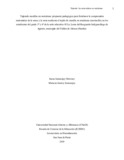Please use this identifier to cite or link to this item:
https://repository.unad.edu.co/handle/10596/26255Full metadata record
| DC Field | Value | Language |
|---|---|---|
| dc.contributor.advisor | Garzón Arcos, Rocío Margarita | - |
| dc.coverage.spatial | cead_-_pasto | spa |
| dc.creator | Janamejoy Mavisoy, Juana | - |
| dc.creator | Jamioy Janamejoy, Mariana | - |
| dc.date.accessioned | 2019-06-13T21:07:53Z | - |
| dc.date.available | 2019-06-13T21:07:53Z | - |
| dc.date.created | 2019-06-11 | - |
| dc.identifier.uri | https://repository.unad.edu.co/handle/10596/26255 | - |
| dc.description | Entrevistas, registros fotográficos y evaluaciones | spa |
| dc.description.abstract | Esta investigación surgió a partir de la baja comprensión matemática en la Institución Educativa Agropecuaria Inga de Aponte, sede 05 la loma Municipio Tablón de Gomez (Nariño)-2019. Ante la problemática del bajo nivel de los estudiantes en los resultados de las pruebas saber primaria e ICFES en secundaria, se propone fortalecer la comprensión matemática de la suma y la resta en los estudiantes del grado tercero y cuarto de la sede 05 de la Institución Educativa Agropecuaria Inga de Aponte (Nariño), a través del tejido de la manilla en muiukuna (mostacilla o chaquira). Esta investigación es de tipo cualitativa con enfoque crítico social, donde su utilizó el método Investigación Acción. Las técnicas de recolección de información fueron el análisis documental, las entrevistas y la observación participante. La propuesta de intervención para abordar este problema fue el diseño de una estrategia pedagogía que consiste en planes de aula bien estructurados y sustentados en el PEC (Proyecto Educativo Comunitario) y el PEI (Proyecto Educativo Institucional). La población estuvo conformada por 6 estudiantes del grado 3 y 4 de la I.E.A.I.A sede 05 la Loma, a quienes se los observó y entrevistó junto con los docentes de área de matemáticas para poder constatar la deficiente compresión de la suma y resta. Durante la aplicación de los planes de aula se utilizó el diario de campo y el cuaderno de notas, los cuales fueron muy válidos para registrar las experiencias de aprendizajes significativos de los estudiantes mientras manipulaban los materiales del tejido en muiukuna. Finalmente, se tuvo en cuenta la teoría de los estadios de desarrollo de Jean Piaget en niños de entre 7 y 11 años, que se encuentran en la etapa de “operaciones concretas”, para apoyar el diseño, implementación y análisis de la propuesta pedagógica. | spa |
| dc.format | spa | |
| dc.format.mimetype | application/pdf | spa |
| dc.language.iso | spa | spa |
| dc.publisher | Universidad Nacional Abierta y a Distancia UNAD | spa |
| dc.title | Tejiendo manillas en muiukuna: propuesta pedagógica para fortalecer la comprensión matemática de la suma y la resta mediante el tejido de manilla en muiukuna (mostacilla) en los estudiantes del grado 3º y 4º de la sede educativa 05 La Loma del Resguardo Indígena Inga de Aponte, municipio del Tablón de Gómez (Nariño) | spa |
| dc.type | Proyecto aplicado | spa |
| dc.subject.keywords | Matematicas - Enseñanza | spa |
| dc.subject.keywords | Etnoeducación | spa |
| dc.subject.keywords | Tejidos indígenas | spa |
| dc.subject.keywords | Estrategias pedagógicas | spa |
| dc.description.abstractenglish | This investigation arose from the low mathematical understanding of the Inga Agricultural Education Institution of Aponte, campus 05 the municipality of Tablón de Gomez (Nariño) -2019. Faced with the problem of the low level of students in the results of the primary and secondary school tests, it is proposed to strengthen the mathematical comprehension of the addition and subtraction in the third and fourth grade students of the campus 05 of the Agricultural Educational Institution Inga de Aponte (Nariño), through the weaving of the handle in muiukuna (mostacilla or chaquira). This research is of a qualitative type with a critical social approach, where was used the Action Research method. The information gathering techniques were documentary analysis, interviews and participant observation. The intervention proposal to address this problem was the design of a pedagogy strategy consisting of well-structured classroom plans and supported by the PEC and the PEI of the educational institution. The population consisted of 6 students from grade 3 and 4 of the I.E.A.I.A campus 05 La Loma, who were observed and interviewed along with teachers in the area of mathematics to verify the poor compression of the addition and subtraction. During the application of the classroom plans, the field diary and the notebook were used, which were very valid to record students significant learning experiences while manipulating the weaving materials in muiukuna. Finally, Jean Piaget's theory of developmental stages was taken into account in children between 7 and 11 years old, who are in the "concrete operations" stage, to support the design, implementation and analysis of the pedagogical proposal. | spa |
| dc.subject.category | Etnoeducación | spa |
| dc.rights.accesRights | info:eu-repo/semantics/openAccess | spa |
| dc.rights.acceso | Abierto (Texto Completo) | spa |
| Appears in Collections: | Licenciatura en Etnoeducación | |
Files in This Item:
| File | Description | Size | Format | |
|---|---|---|---|---|
| ju10jan524.pdf | Proyecto aplicado_Tejiendo manillas en muiukuna: propuesta pedagógica para fortalecer la comprensión matemática de la suma y la resta mediante el tejido de manilla en muiukuna (mostacilla) en los estudiantes del grado 3º y 4º de la sede educativa 05 La Loma del Resguardo Indígena Inga de Aponte, municipio del Tablón de Gómez (Nariño) | 1.43 MB | Adobe PDF |  View/Open |
Items in DSpace are protected by copyright, with all rights reserved, unless otherwise indicated.
